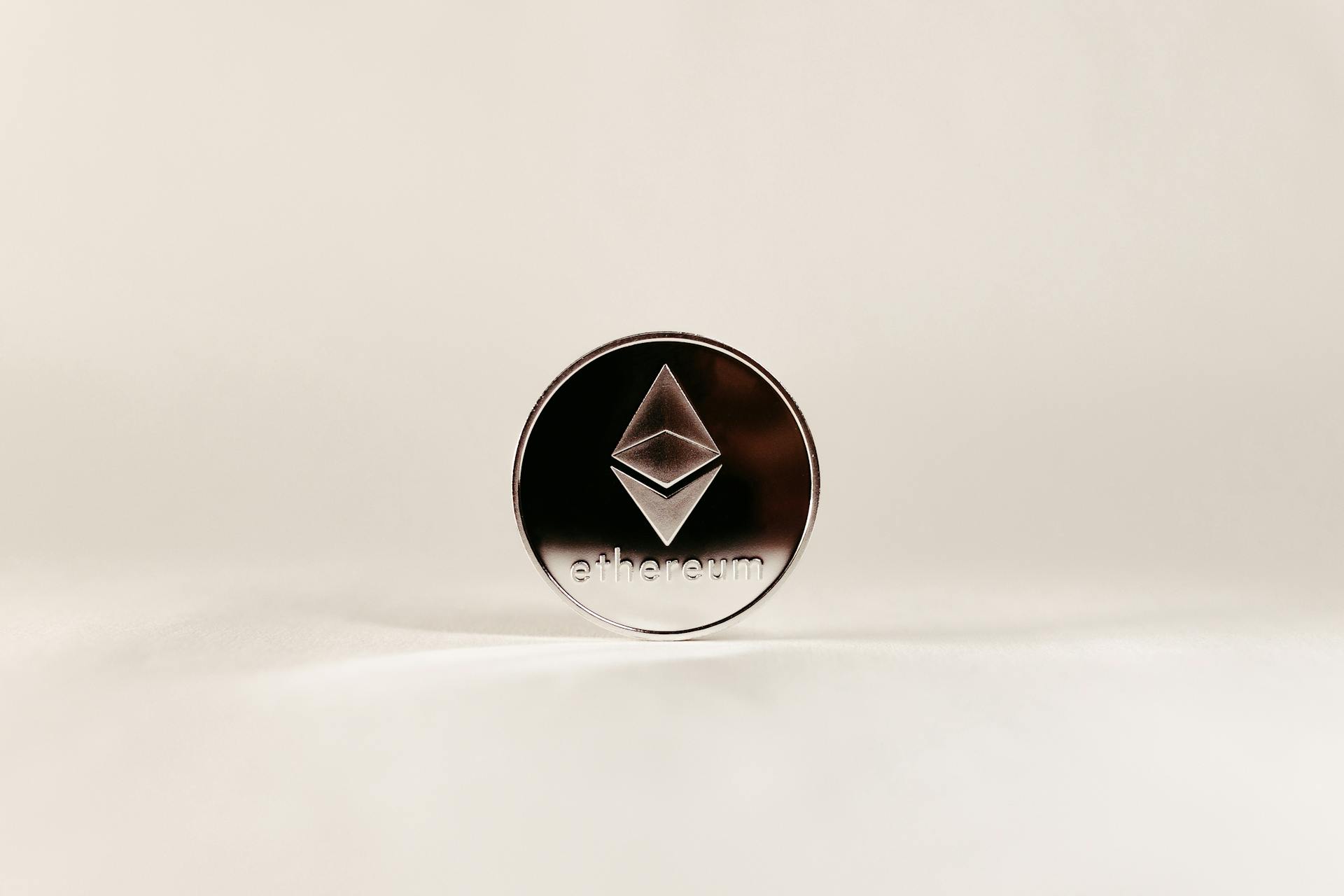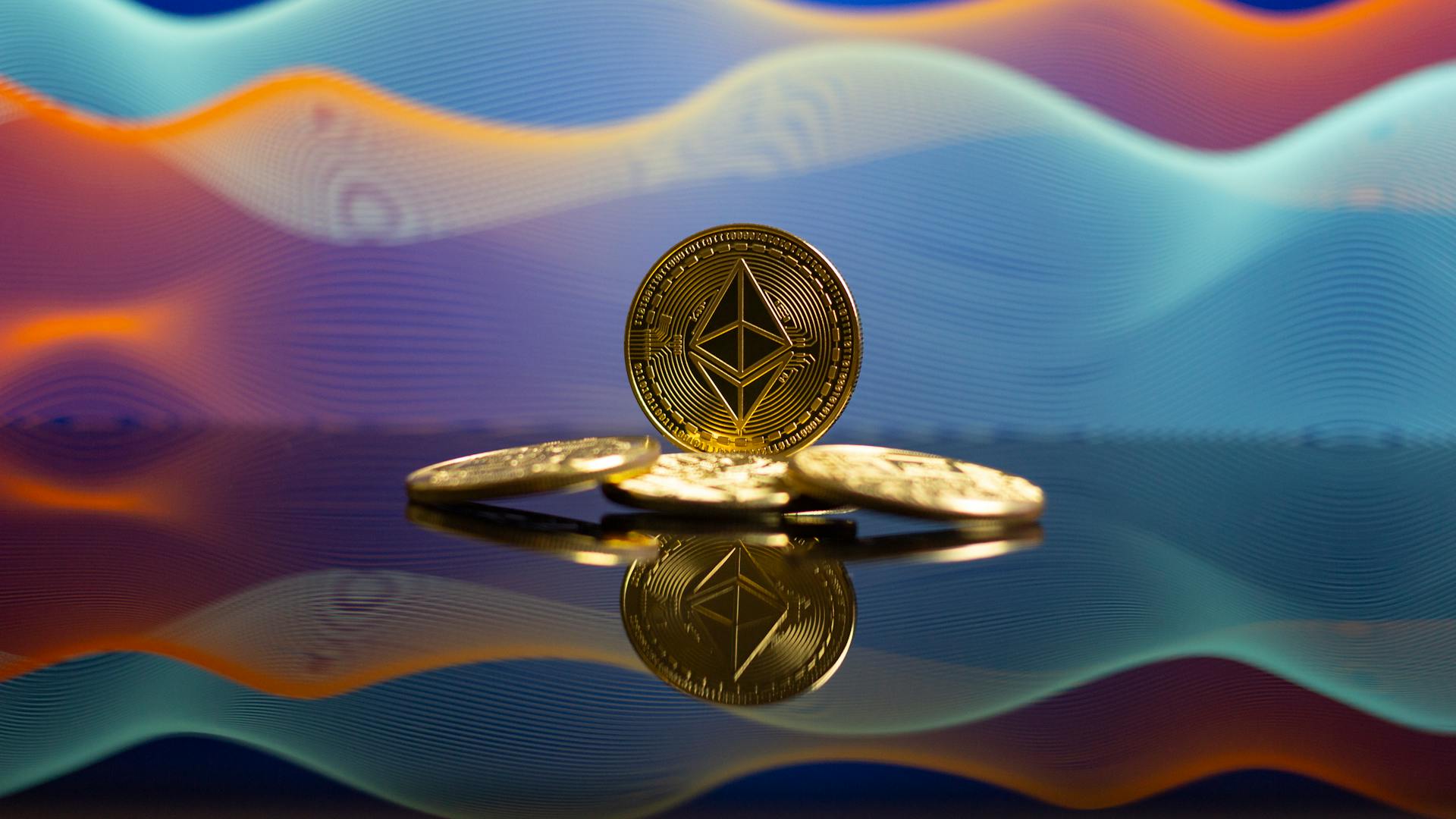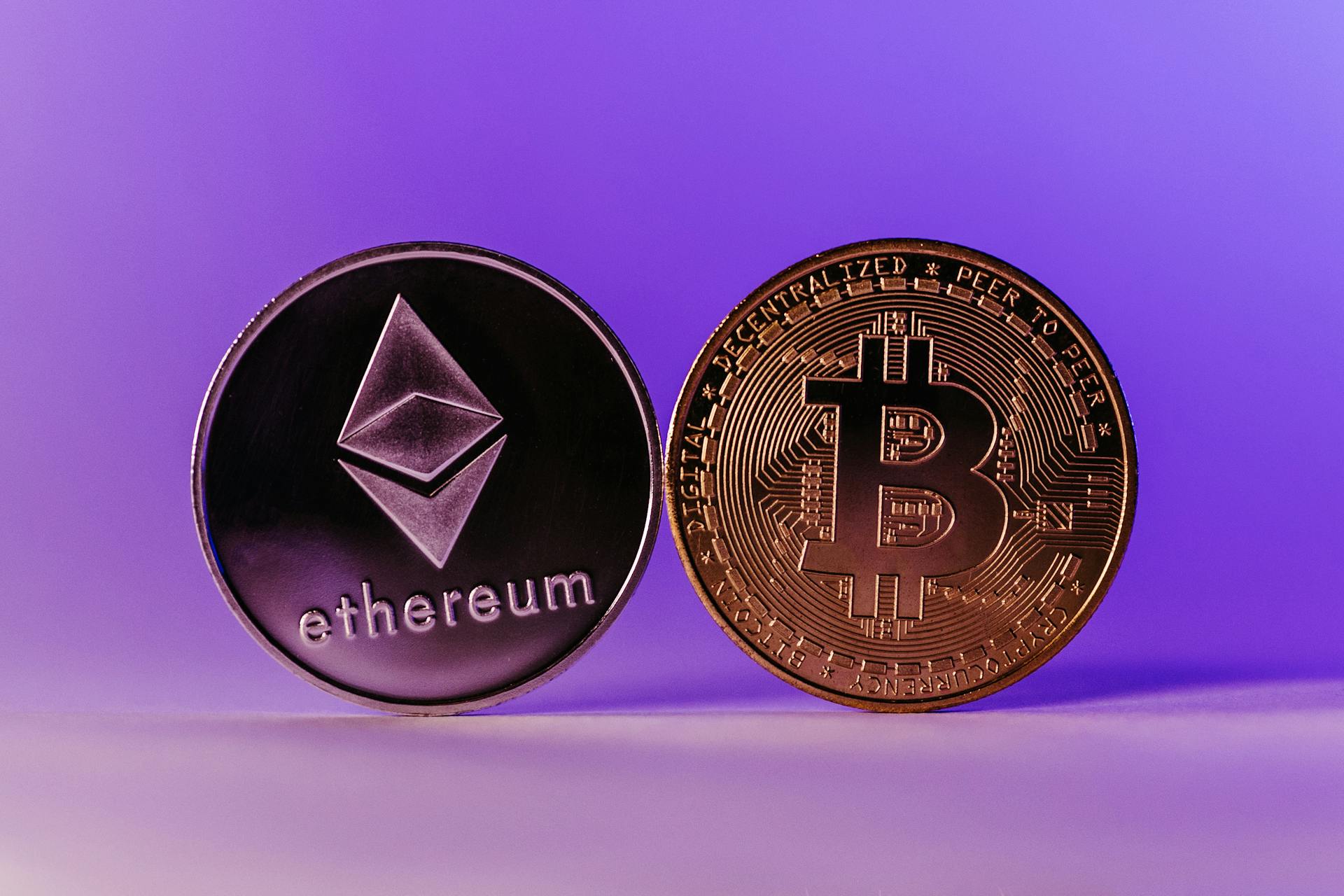
Ethereum is a game-changer in the world of blockchain technology. It's not just a digital currency like Bitcoin, but a platform that enables the creation of smart contracts and decentralized applications (dApps).
Ethereum's impact on the blockchain is significant because it allows for the development of complex applications that can automate various tasks and processes. This has opened up new possibilities for industries such as finance, healthcare, and supply chain management.
One of the key features of Ethereum is its use of a programming language called Solidity, which is used to create and deploy smart contracts. This has enabled developers to build a wide range of applications, from simple games to complex financial instruments.
The Ethereum network has also enabled the creation of decentralized finance (DeFi) applications, which are changing the way people borrow, lend, and trade financial assets.
See what others are reading: How to Make Money with Smart Contracts
Ethereum Use Cases
Ethereum is a versatile platform that has found its way into various industries, from healthcare to entertainment. It's being used to create novel tools that enhance efficiency, trust, and democratize access to services.
In the music industry, Ethereum is providing an ideal solution for managing royalties by distributing tokens that represent ownership rights. This enables automated and seamless distribution of royalty payments.
Ethereum is also being used in the gaming and virtual reality space, with platforms like Decentraland and Axie Infinity tokenizing virtual items and environments. This creates a sense of ownership and allows for secure and transparent transactions.
Decentralized finance (DeFi) is another area where Ethereum is thriving, with platforms like Compound, MakerDAO, and Aave offering peer-to-peer borrowing and lending, interest on crypto holdings, and decentralized exchange mechanisms.
Expand your knowledge: Peer to Peer Exchange Crypto
Decentralized Finance
Decentralized finance (DeFi) is the newest innovation to see an avalanche of use and growth on Ethereum. In 2020, the total value locked in DeFi platforms eclipsed $4 billion.
DeFi platforms are reinventing traditional financial products and services by adding programmable, decentralized, and censorship-resistant features to create brand new financial products. This includes peer-to-peer (P2P) borrowing and lending, interest on crypto holdings, decentralized exchange (DEX) mechanisms, stablecoins, and composable features that maximize passive earning opportunities.
Recommended read: Decentralized Finance Courses
Some popular DeFi platforms include Compound, MakerDAO, and Aave. These platforms are making it possible for people to access financial services in a more efficient and secure way, without the need for intermediaries.
The decentralized nature of DeFi platforms allows for greater transparency and security, as all transactions are recorded on the blockchain and can be viewed by anyone. This transparency is key to building trust in the system.
Use in Gaming
Ethereum is being used to create virtual worlds and games where players can own and trade digital assets. Decentraland is a great example of this, where virtual land, avatars, and buildings are all tokenized on the Ethereum blockchain.
Players can buy, sell, and trade these digital assets securely and transparently, thanks to Ethereum's blockchain technology. This creates a new way for gamers to engage with virtual worlds and each other.
Axie Infinity is another game that's using blockchain technology to create a new type of gaming experience. Players can earn rewards and make transactions within the game using the cryptocurrency Smooth Love Potion (SLP).
You might enjoy: How to Trade Ethereum
Smart Contracts
Smart contracts are the backbone of Ethereum's functionality, allowing for secure, trustworthy, and decentralized agreements between parties. They're essentially self-executing contracts with the terms of the agreement written directly into lines of code.
A smart contract is a computer protocol that verifies, enforces, or facilitates the performance and negotiation of a contract without the need for a third party. This is how different players can come together and create applications and services on a decentralized platform.
The idea behind smart contracts was first described by computer scientist Nick Szabo in 1996, who wanted to provide a secure and trustworthy way for contracting between strangers on the internet. His intention was to make traditional contracts less expensive and more secure at the same time.
Smart contracts can involve any number of players located anywhere in the world, thanks to blockchain technology. However, the actual smart contract is not distributed throughout the network to all the computers but is instead housed on the server of the smart contract's creator.
The technical standard used for smart contracts on the Ethereum blockchain is ERC-20, which is used for implementing tokens. Smart contracts are transparent and unchangeable, making it impossible for one party to later alter the terms of the contract in their favor.
Here are some key characteristics of smart contracts:
- Transparent: Smart contracts are visible to all parties involved, allowing for complete transparency.
- Unchangeable: Once a smart contract is created, it cannot be altered or modified.
- Self-executing: Smart contracts automatically execute the terms of the agreement when the conditions are met.
- Decentralized: Smart contracts are hosted on a decentralized network, allowing for peer-to-peer transactions.
Smart contracts are a powerful tool for creating secure and trustworthy agreements between parties, and they're a key component of the Ethereum platform.
Ethereum Technology
Ethereum uses blockchain technology, just like Bitcoin, but it allows for more than just cryptocurrency transactions. Ethereum's blockchain is a digital ledger where Ether can be securely stored and exchanged.
The Ethereum blockchain is a decentralized system, meaning there's no governing authority controlling the network. It's made up of thousands of computers, each containing a complete record of all transactions.
Ethereum's platform offers the Ethereum Virtual Machine (EVM), which executes scripts worldwide across its network of distributed public nodes. This allows developers to create their own blockchain applications.
The Ethereum platform uses a consensus algorithm called Proof of Work (PoW) to execute and verify transactions, but it transitioned to Proof of Stake (PoS) on September 15, 2022, which potentially offers faster transaction speeds and uses less energy.
Here's an interesting read: Xrpl Uses
Blockchain Technology
Blockchain technology is a method of using cryptographic fundamentals to link blocks of digital records kept on a group of computers. Each computer contains a complete record of all transactions, making the system highly secure and resistant to collapse.
The blockchain network is decentralized, with no governing authority controlling it. This means that the records are open to the public and can be accessed by anyone.
Each new transaction undergoes an in-depth mathematical verification process, making it virtually impossible to forge or alter records. This is achieved through the use of cryptographic principles that prevent tampering.
The network involves thousands of computers, which ensures that even if one computer fails, the system remains intact. This is a key benefit of blockchain technology, providing a high level of security and reliability.
Blockchain technology can be used to store personal data, such as social media profiles, in a safer and more secure way. This is being explored by developers who want to give users more control over their data.
In theory, anyone hoping to maliciously alter a record would have to alter every occurrence of that record on every computer in the world participating on that network. This is a significant challenge, making it highly unlikely that records will be tampered with.
For more insights, see: Bit Coin Record
What Sets It Apart
Ethereum is a unique platform that invites outside developers to create their own applications.
This open-door policy sets it apart from other cryptocurrencies like Ripple, which is an exclusive network devoted to its own services.
Many other cryptocurrencies, including some of the most widely circulated currencies, run on the Ethereum platform.
People often get confused between the Ethereum network and its native currency, ether, but remember that they're technically trading ether, not Ethereum.
Ethereum's multi-purpose software platform is a key differentiator from other cryptocurrencies, allowing developers to create their own applications and launch new cryptocurrencies.
For another approach, see: How Many Bitcoins Does Tesla Own
Scalability Solutions
Ethereum is working on a scalability solution called danksharding. This approach aims to greatly reduce costs and increase transaction processing speeds.
Danksharding uses BLOBs to post transactions to the main chain. BLOBs are Binary Large OBjects that can efficiently store and transmit data.
Transactions are processed off-chain, then rolled up and summarized using data availability sampling. This process enables faster and more cost-effective transaction processing.
You might enjoy: Chain Wallet Crypto
Danksharding is expected to be a significant improvement over previous plans for sharding. Sharding would have allowed portions of the blockchain to be stored on nodes, but danksharding is a more efficient solution.
The combination of BLOBs, rollups, and data availability sampling will likely make a big difference in the usability of Ethereum.
Proof-of-Stake (PoS)
Proof-of-Stake (PoS) is the second-most frequently used consensus mechanism in blockchain technology, offering significantly lower energy consumption compared to Proof of Work (PoW).
No mining is involved in PoS, which means the energy consumption is far below that of PoW.
A staker is chosen to create the next block on the chain and is rewarded with transaction fees.
In the Ethereum network, participants can be involved by putting up a certain stake, such as placing a certain amount of ETH in a wallet connected to the Ethereum blockchain.
On a similar theme: Bitcoin Mining Energy Consumption
Ethereum Applications
Ethereum can be applied to a wide range of use cases, including crowdfunding, financial exchanges, company governance, domain names, intellectual property, and voting.
One of the most exciting applications of Ethereum is in the realm of decentralized finance (DeFi), where users can carry out activities such as lending, borrowing, and trading cryptocurrencies.
Ethereum-based projects, such as the Microsoft and ConsenSys partnership, are also exploring the use of Ethereum for enterprise software development.
Here are some examples of Ethereum applications:
- Crowdfunding
- Financial exchanges
- Company governance
- Domain names
- Intellectual property
- Smart property with hardware integration
- Voting
- Contracts and agreements
Ethereum can also be used for buying and selling cryptocurrencies, hosting smart contracts and decentralized apps (dApps), and exchanging non-fungible tokens (NFTs).
Web3
Web3 is a concept that's still being developed, but it's likely to be powered by Ethereum. Many applications being built for the "future of the internet" are using Ethereum.
Ethereum is being used to build the metaverse, a virtual world that could change the way we interact with each other. This includes virtual wallets, decentralized apps, and virtual buildings.
The metaverse is expected to be a key part of Web3, and Ethereum is likely to be at its core. This is because many of the applications being developed for the metaverse are built on Ethereum.
Expand your knowledge: Metaverse Crypto Coins
Here are some examples of how Ethereum is being used in the metaverse:
- Virtual wallets to store and manage digital assets
- Decentralized apps (dApps) to provide services and experiences
- Virtual buildings and spaces to interact with others
These applications are being built to provide a more immersive and interactive experience for users. They're also being designed to be decentralized, meaning that they're not controlled by a single entity.
The potential of Web3 and the metaverse is vast, and Ethereum is likely to play a key role in its development. As more applications are built on Ethereum, we can expect to see new and innovative uses for the technology.
DApps
DApps are built on the Ethereum blockchain, allowing for decentralized computation and a reliable customer experience. This is because essential components are distributed across the network, making it almost impossible to attack.
Developers are charged in Ether for using the computing power in the network, which helps to maintain the decentralized nature of DApps. This is a key advantage of building on the Ethereum blockchain.
One of the most important recent additions to the Ethereum ecosystem is Uniswap, a Decentralized Automated Exchange (DEX) protocol. Uniswap allows its users to trade and swap ERC20 tokens without any intermediary on a highly decentralized network.
Here are some of the key features of DApps built on the Ethereum blockchain:
- Decentralized computation
- Reliable and secure customer experience
- Developers are charged in Ether for using computing power
- Essential components are distributed across the network
These features make DApps a powerful tool for building decentralized applications on the Ethereum blockchain.
Ethereum Comparison
Ethereum has some key similarities with Bitcoin, but it also has some significant differences. Ethereum is an open-source, decentralized, blockchain-based platform, just like Bitcoin.
One major difference is that Ethereum is not just a digital currency, but also a platform for building and deploying smart contracts and decentralized applications (dApps). It has a more complex architecture than Bitcoin.
Ethereum's gas limit, which is the maximum amount of computational power that can be used to process transactions, is much higher than Bitcoin's block size limit. This allows for more complex and data-intensive transactions on the Ethereum network.
Ethereum's programming language, Solidity, is used to build and deploy smart contracts on the Ethereum network. It's a bit more complicated to use than Bitcoin's scripting language, but it's still relatively accessible to developers.
Ethereum's consensus algorithm, proof-of-work (PoW), is similar to Bitcoin's, but it's also experimenting with proof-of-stake (PoS) and other consensus algorithms. This is because Ethereum is more focused on scalability and usability than Bitcoin.
A fresh viewpoint: Bitcoin Atm Limit per Day
Ethereum Development
Ethereum is a decentralized platform that allows developers to build and deploy their own applications, known as dApps, on top of its blockchain.
The Ethereum Virtual Machine (EVM) is the runtime environment for smart contracts, which are self-executing contracts with the terms of the agreement written directly into lines of code.
Developers can write smart contracts in a variety of programming languages, including Solidity, Serpent, and Vyper.
Ethereum's decentralized nature allows developers to create and manage their own blockchain networks, giving them full control over their applications.
The Ethereum development process involves several stages, including planning, designing, coding, testing, and deploying the application.
Developers can use a range of tools and frameworks, such as Truffle and Web3.js, to build and deploy their dApps on the Ethereum network.
Ethereum's open-source nature and large community of developers make it an attractive platform for developers to build and deploy their applications.
Related reading: Do You Own Crypto on Robinhood
The Future
The Future of Ethereum is exciting, with a significant upgrade that's enabled users to validate transactions and mint new ETH based on their ether holdings. This upgrade has added capacity to the Ethereum network, which will eventually help to address chronic network congestion problems that have driven up gas fees.
Ethereum now has two layers: the execution layer, where transactions and validations occur, and the consensus layer, where attestations and the consensus chain are maintained. This new setup has improved the overall efficiency of the network.
See what others are reading: An Airdrop of New Cryptocurrency following a Hard Fork Is
Featured Images: pexels.com


